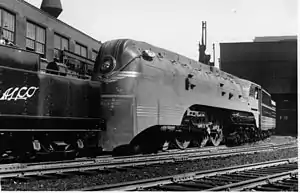Milwaukee Road class F7
The Milwaukee Road's class "F7" comprised six (#100–#105) high-speed, streamlined 4-6-4 "Baltic" (Hudson) type steam locomotives built by the American Locomotive Company (ALCO) in 1937–38 to haul the Milwaukee's Hiawatha express passenger trains. Following on from the success of the road's class "A" 4-4-2s, the F7s allowed the road to haul heavier trains on the popular Chicago–Twin Cities routes.
| Milwaukee Road class F7 | |||||||||||||||||||||||||||||||||||||||||||||||||
|---|---|---|---|---|---|---|---|---|---|---|---|---|---|---|---|---|---|---|---|---|---|---|---|---|---|---|---|---|---|---|---|---|---|---|---|---|---|---|---|---|---|---|---|---|---|---|---|---|---|
 A class F7 being moved out of the Alco factory | |||||||||||||||||||||||||||||||||||||||||||||||||
| |||||||||||||||||||||||||||||||||||||||||||||||||
| |||||||||||||||||||||||||||||||||||||||||||||||||
| |||||||||||||||||||||||||||||||||||||||||||||||||
| |||||||||||||||||||||||||||||||||||||||||||||||||
The F7s are major contenders for the fastest steam locomotives ever built, as they ran at over 100 miles per hour (160 km/h) daily. One run in January 1941 recorded by a reporter for Trains magazine saw 110 miles per hour (180 km/h) achieved twice—in the midst of a heavy snowstorm. Baron Gérard Vuillet, a French railroading expert, once recorded a run between Chicago and Milwaukee where the locomotive reached 125 mph (201 km/h) and sustained an average 120 mph (190 km/h) for 4.5 miles (7.2 km).[1] However, the British locomotive LNER Class A4 4468 Mallard is officially accepted to be the world's fastest, with a run recorded at 125.88 mph (202.58 km/h) but authenticated at 126 mph in 1938. The Mallard run was slightly downhill and the locomotive broke down at the end of the run.
The Milwaukee F7s are accepted as the fastest steam locomotives by a different measure—scheduled speed between stations. In 1939, shortly after they were introduced into passenger service, the Twin Cities Hiawatha schedule was modified such that the engines would need to run the 78.3 mi (126.0 km) between Portage and Sparta, Wisconsin in 58 minutes—a start-to-stop average of 81 mph (130 km/h).[1]
In the late 1940s, the Milwaukee F7s were modified to equip an additional Mars Light above the original single highlight to further enhance the safety of daily highspeed operation.
On July 27, 1950, F7 #102 was on a run between Chicago and Milwaukee on the "North Woods Hiawatha." 73 miles from Milwaukee, the right main crosshead froze in its guide. It immediately overheated, broke, and dropped from the guide while the train was traveling at an estimated speed between 90 and over 100 mph. Air brake lines were severed, putting the engine into emergency. The engine was severely damaged, broken drive gear tore up ties and roadbed, and debris (including the main rod) was found as far as 1400 feet west of Edgebrook Station. Information is conflicting on the number of injuries that resulted: Some report that two railroad employees were injured, while another report stated that as the locomotive passed by the Devon Avenue crossing an automobile driver was injured by flying debris. Whatever the case, no one was killed. The train stayed on the rails, and continued to over 10,560 feet from the station until coming to a complete stop.[2] The cause of the incident was later found to have been caused by the failure of a connection link between the valve gear's combination lever and a Nathan mechanical lubricator. In fact, both of the locomotive's crossheads had been running dry on lubrication, but the right one was the first to fail. After this incident, #102 never ran again, as the cost was not considered worth repairs.
The first one built, #100, was also the first withdrawn from service, on November 10, 1949; and the last one built #105 was the final one in service and was withdrawn August 10, 1951. None survive today, as the last one was scrapped in 1951.
| Milwaukee Road No. | Alco serial No. | Built | Retired |
|---|---|---|---|
| 100 | 69064 | August 1938 | November 1949 |
| 101 | 69065 | August 1938 | April 1951 |
| 102 | 69066 | August 1938 | August 1950 |
| 103 | 69067 | August 1938 | June 1951 |
| 104 | 69068 | September 1938 | June 1951 |
| 105 | 69069 | September 1938 | August 1951 |
See also
- Chicago and North Western class E-4 - nine very similar 4-6-4 type locomotives built for the Milwaukee's Chicago competitor, the Chicago and North Western Railway.
- AT&SF class 3460 - six similar 4-6-4 type locomotives with the same boiler pressure and driving wheel size, also used in Chicago by the Santa Fe Railway.
Notes
- Scribbins 1970, p. 63.
- Young, Jan (30 November 2017). Fashion in Steel: Streamlined Steam Locomotives in North America. Lulu.com. ISBN 9781387408610.
- Edson 1977, p. 51.
- Scribbins 1970, pp. 226–227.
References
- Benn, Bryan. "Fastest Steam Locomotive". Archived from the original on 2006-04-20. Retrieved 2010-02-05.
- Edson, William D. (Spring 1977). "Milwaukee Road Locomotives". Railroad History. The Railway and Locomotive Historical Society, Inc. (136): 28–129.
- Hollingsworth, Brian; Cook, Arthur (2001). The Great Book of Trains. Osceola, Wisconsin: MBI Publishing. ISBN 0-7603-1193-5.
- King, Ed; Scribbins, Jim (Spring 2002). Classic Trains. Vol. 3, no. 1. Kalmbach Publishing Co. pp. 65–73.
{{cite magazine}}: Missing or empty|title=(help) - Reed, Brian (1972). Loco Profile 26 – The Hiawathas. Windsor, Berkshire, UK: Profile Publications Ltd.
- Ross, Don. "Chicago Milwaukee St. Paul & Pacific: 4-6-4s". Don's Rail Photos. Retrieved 2011-11-07.
- Scribbins, Jim (1970). The Hiawatha Story. Milwaukee, Wisconsin: Kalmbach Publishing Company. LCCN 70107874. OCLC 91468.
External links
![]() Media related to Milwaukee Road class F7 at Wikimedia Commons
Media related to Milwaukee Road class F7 at Wikimedia Commons